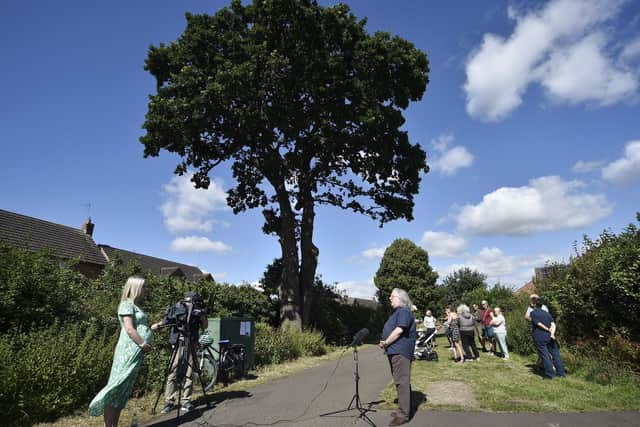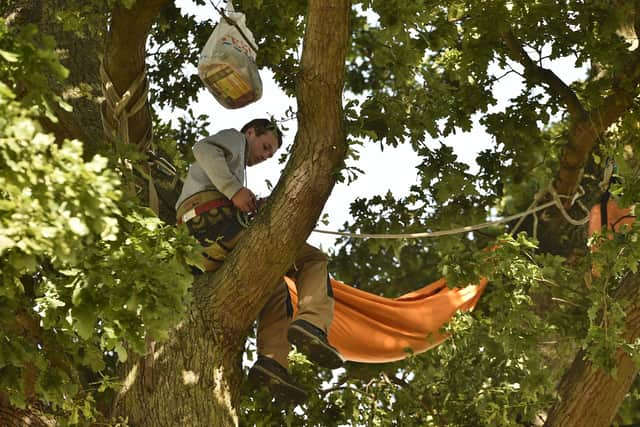Tree felling cases won’t automatically go in front of planning officers, report says
and live on Freeview channel 276
Peterborough City Council is reviewing its tree management policy, following lessons learned after the Bretton oak was felled.
A new report has been written in the aftermath of the high profile felling of the oak tree in June this year, which is now believed to be 300 years old as opposed to 600, as widely reported.
Advertisement
Hide AdAdvertisement
Hide AdDespite the huge public campaign to save it, Peterborough City Council cut down the tree in Ringwood because it was causing "structural damage" to nearby homes.


The new report reviews the existing policy for managing tree related subsidence claims against the council.
Essentially, it also allows for the Cabinet to determine if any changes to the Trees and Woodland Strategy, published first in 2018, should be adopted.
A key recommendation of the report was to automatically refer council-owned trees with Tree Protection Orders (TPOs) to the planning committee, following a feeling of disappointment after the oak tree wasn’t referred to planning officers this year.
Advertisement
Hide AdAdvertisement
Hide Ad

However, after the Climate Change and Environment Scrutiny Committee reviewed this idea the group said no to automatically bringing all cases of trees in front of planning officers.
Instead, officers should ‘rely on the existing procedures in place’.
The report was introduced by councillor Nigel Simons, Cabinet Member for Waste, Street Scene, and the Environment at the Cabinet meeting on 17 October.
He said: “Managing our tree stock and where possible expanding it, is a huge challenge.
Advertisement
Hide AdAdvertisement
Hide Ad"We have 20 per cent tree-canopy on Peterborough City Council land, with targets to increase that number, and while our tree strategy is already highly regarded, given the issues we had with the Bretton Oak, we felt our policy should be looked at.”
‘Matter turned into politics’
Councillor Simons said due process was followed when the Bretton oak tree was axed.
“The process we went through was robust and very much in line with the policy, the only difference being was that it wasn’t clearly communicated at that stage. With the aid of this policy people can understand how we analyse these cases and hopefully draw the right conclusions.”
Councillor Fitzgerald added: “I think that Cllr Simon's suggestion that these cases go to planning actually reinforces the case in terms of protection, and gives a wider cross-party, no bias, no politics in that. Nobody wants to see trees felled unnecessarily – particular Cllr Ayers and I, as the tree was in our ward – but the matter was turned into a political matter by some members of this council – but I want to reiterate we don’t take these matters lightly.”
Advertisement
Hide AdAdvertisement
Hide AdThe new report recognises that this is not an easy matter to deal with.
It states: ‘It is however becoming increasingly evident that trees currently pose the single most significant insurance liability to Peterborough City Council (I.e. a greater risk, for example, than that posed by our highways)
‘Proven claims totalling £1.13million have been received by the council over the last seven years - with the number of claims ranging depending on the lack of rainfall.’
The report adds: ‘Over the past few years, responding to these cases has almost entirely been on the basis of felling trees where a proven case of damage exists.
Advertisement
Hide AdAdvertisement
Hide Ad‘Felling is the simplest, cheapest, and proven way of dealing with the matter and costs would have been substantially more if alternative (non-felling) options were taken (estimated to be within the range of £5-10 million), and sometimes no alternative to felling is possible (for practical or legal reasons).
The Bretton oak tree was the last remaining of a row of similar trees – all now cut down – on Blind Lane.
In 1970, long before any houses were built, the trees were protected with a covenant stating that future properties should not be grown too close to them, avoiding potential issues with the roots. In 1998, Peterborough City Council granted a planning application and the houses on Barnards Way were built.
However, one house in Barnards Way, had a conservatory added to the rear of the property significantly reducing the distance from the house and its extension to the tree.
The roots of that tree – the last oak standing – were said to be interfering with the property to the extent that the home insurance company would not insure the building.
